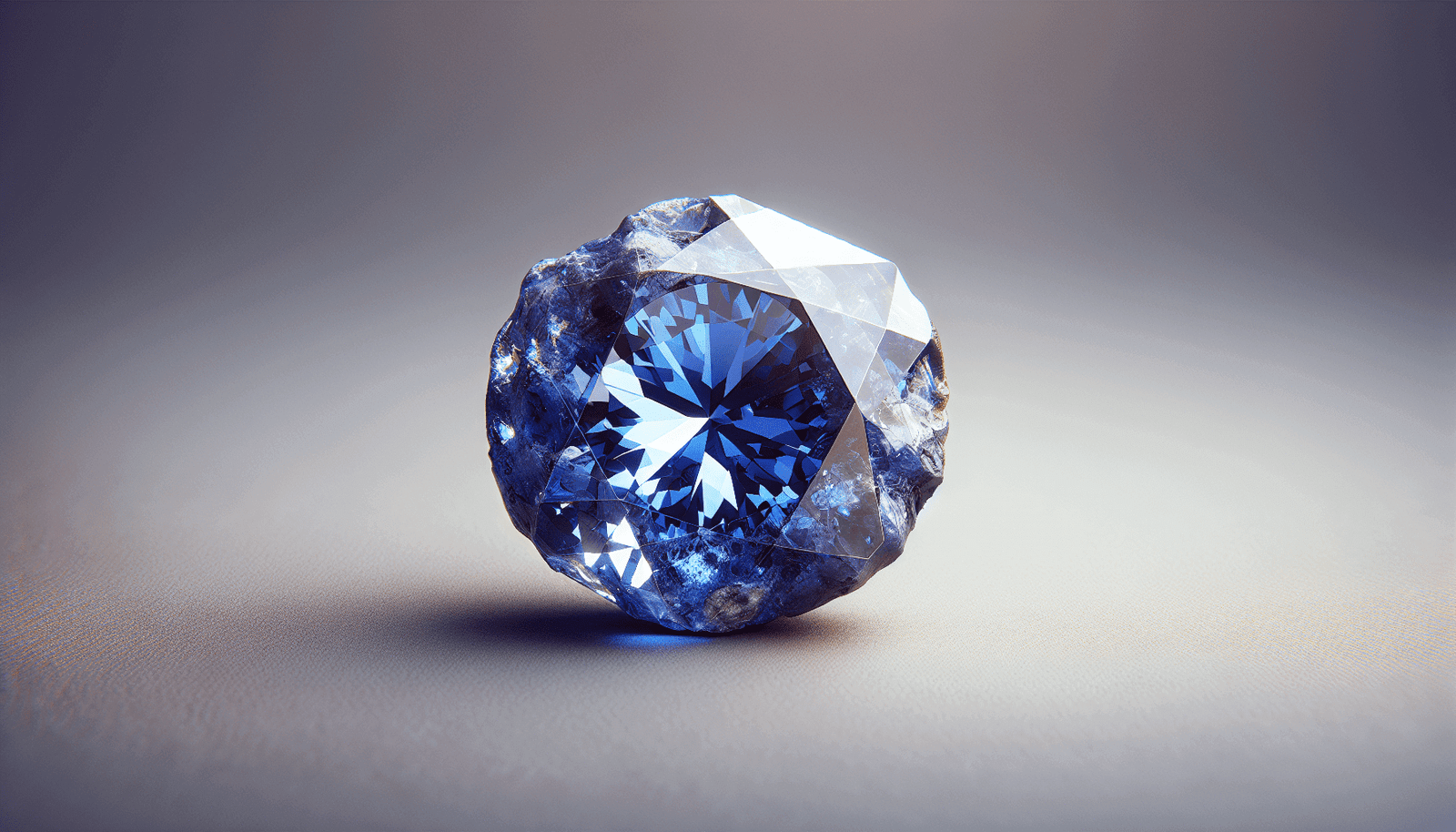You’ve probably held a diamond in your hand or seen one sparkling on a jewelry store display, but have you ever come across Tanzanite? It’s an incredible gemstone, even rarer than the coveted diamond. This fascinating article draws an exciting comparison between tanzanite and diamonds, exploring just how extraordinary tanzanite is. Get ready to uncover the unique allure of tanzanite, and see why these stones may just be the crown jewels of your collection.

1. Understanding Tanzanite
Let’s start by unpacking what tanzanite is. Tanzanite is a richly colored gemstone, boasting a blue-violet hue that’s downright vibrant. It’s up to 1,000 times rarer than a diamond, owing its existence to a unique geological phenomenon. Treasured by gem enthusiasts and collectors, tanzanite is a relative newcomer among the world’s gemstones since it was only officially discovered in the 1960s.
An overview of Tanzanite
Tanzanite is fundamentally a blue variety of the mineral zoisite and owes its existence to the unique geology of northern Tanzania. It’s the only place on Earth where this mesmerizing gemstone can be found, largely contributing to its rarity and making it highly sought-after.
Discovery and History of Tanzanite
If we take a trip back in history, unlike most other gemstones that have been known for centuries, tanzanite was only discovered in the mid-20th century. The first tanzanite was found in 1967 by a Masai tribesman. Soon after, the lush-blue gem caught the attention of Tiffany & Co., which was captivated by its vivid colors and rare origin. Tiffany named the gem after Tanzania, the country where it was found, and launched a massive advertising campaign that catapulted tanzanite into the global gemstone industry.
Properties of Tanzanite
Tanzanite is acclaimed for its exotic color range from ultramarine to light violet-blue. One unique property of tanzanite is its strong pleochroism, which means it can show different colors depending on the viewing direction. This gemstone ranks 6.5 to 7 on the Mohs scale, indicating it’s relatively soft compared to other gemstones, and therefore should be worn with care to avoid scratches and sharp impacts.
Tanzanite Extraction and Production
To put it simply, the extraction process of tanzanite is vigorous. Tanzanite mining happens in the Merelani Hills near Arusha in Northern Tanzania, in a small area that’s less than four square miles wide. Due to its single-source locality, tanzanite mining is a delicate and demanding task. Miners have to delve into narrow shafts and carefully remove the host rock where the valued tanzanite is found. After mining, the tanzanite is carefully cut and polished, going from a rough stone to a sparkling gem.
2. Understanding Diamonds
Now, let’s cast our gaze on diamonds. Diamonds are undeniably the most famous gemstone, adored for their fiery brilliance, enduring hardness, and captivating beauty.
A general look at diamonds
Diamonds are composed of carbon and are formed deep within the Earth’s mantle under high temperature and pressure conditions that exist only in certain locations around the world. They are brought closer to the Earth’s surface through deep volcanic eruptions. The most significant characteristic that sets diamonds apart from other gemstones is their incredible hardness, which contributes to their iconic sparkle and durability.
Discovery and history of Diamonds
The discovery and history of diamonds stretches back to ancient times. Diamonds were first discovered in India over 2,000 years ago, and since then, they have been revered for their unmatchable brilliance and strength. They were used in religious icons, as engraving tools, and as a means of protection in battle due to their hard nature. Moreover, diamonds have long been associated with love and romance, symbolizing steadfastness and enduring affection.
Properties of Diamonds
Diamonds are renowned for their physical properties, most notably, their hardness. A diamond is the hardest known natural substance, rating a 10 on the Mohs scale of hardness. This surpasses any other gemstone, allowing it to retain its polish for much longer and resist scratches. Besides their hardness, diamonds are also appreciated for their incredible brilliance and fire. This is due to their high refractive index, which means they can bend and scatter light to a high degree, resulting in the intense sparkle diamonds are famous for.
Diamond Extraction and Production
Diamond extraction is a labor-intensive process that requires both technical expertise and heavy machinery. Diamonds are predominantly extracted from kimberlite pipes, which are volcanic conduits that bring diamonds up from their formation zones within the Earth. The process of transforming a rough diamond into a polished gem is called diamond cutting, which is a highly specialized and technical process that requires exceptional skill and precision.

3. The Rarity of Tanzanite
Rarity is a significant factor in the gemstone world, especially when talking about tanzanite. It not only contributes to the gemstone’s value but also adds to its prestige and desirability among collectors and enthusiasts.
Defining Rarity in Gemstones
When it comes to gemstones, rarity can be defined by several factors. These factors include a gem’s geological occurrence, its availability on the market, its color or quality, and whether it is found in a limited geographical area. By these definitions, tanzanite can be considered a rare gemstone.
The Limited Geographic Presence of Tanzanite
When speaking about the rarity of tanzanite, one cannot ignore its limited geographical presence. Being sourced from only one place on the entire planet, the Merelani Hills near Arusha in Northern Tanzania significantly contributes to its rarity. This single-source locality means that the supply of tanzanite is highly finite, hence increasing its value in the gemstone market.
Average Extraction Quantity per Year
The quantity of tanzanite extracted each year also plays a large role in its rarity. Although exact figures are difficult to confirm due to the relative secrecy of the industry, it’s estimated that the yield is quite small compared to other gemstones. This scarcity of supply, coupled with increasing demand, amplifies the rarity and value of tanzanite.
Predicted Depletion of Tanzanite Reserves
Given tanzanite’s single-source locality and dwindling supply, the gemstone industry has raised concerns about the depletion of tanzanite reserves. Geological surveys have suggested that at the current rate of extraction, tanzanite reserves may be depleted within the next few decades. This projection further underscores the rarity and future value of this unique gem.
4. The Rarity of Diamonds
While diamonds are more widely available than tanzanite, their rarity is nonetheless significant due to other factors such as their formation process, size, and quality.
Availability of Diamonds Globally
Unlike tanzanite, diamonds are found in numerous locations around the globe. Major diamond-producing countries include Russia, Botswana, and the Democratic Republic of Congo, among others. While the geographical availability of diamonds is broader than tanzanite, it does not diminish their rarity. The diamond formation process is a complex geological phenomenon that takes place over billions of years under specific conditions, making every diamond unique and in its own way, rare.
Average Extraction Quantity per Year
The diamond industry extracts approximately 130 million carats of rough diamonds each year. While this might sound like a large number, it’s important to note that only a small fraction of these diamonds will be of gem quality suitable for jewelry. Most of the extracted diamonds are used for industrial purposes due to their hardness. Therefore, the number of high-quality diamonds available for jewelry is much scarcer than one might initially assume.
Predicted Depletion of Diamond Reserves
While diamonds are more widespread than tanzanite, their reserves are not infinite. Predictions on the depletion of diamond reserves vary significantly, primarily due to uncertainties about undiscovered diamond deposits. The consensus is that known diamond reserves could be depleted within the next few decades if no new significant deposits are discovered.

5. Comparing Tanzanite and Diamond Rarity
When comparing the rarity of tanzanite and diamonds, it’s crucial to consider multiple factors to provide a comprehensive perspective.
Comparison based on Geographical Presence
When it comes to geographical presence, tanzanite is incomparably rarer. As we have already noted, tanzanite is found in only one place in the world, which is a tiny area in Tanzania. Whereas diamonds, on the other hand, can be discovered in numerous countries across several continents.
Comparison based on Yearly Extraction
In terms of yearly extraction, more diamonds are mined each year than tanzanite. This is partly due to the fact that diamonds are found in more places and are much further along in terms of mining technology and industry development.
Comparison based on Reserve Depletion Predictions
Both Tanzanite and diamonds face the reality of resource depletion. However, the case of Tanzanite is more urgent due to its single-source locality and diminishing reserves.
6. Further Factors Affecting Rarity
There are other factors to consider that can also impact the perceived rarity of tanzanite and diamonds.
Impact of Synthetic and Imitation Gemstones
Synthetic and imitation gemstones certainly pose a challenge to the natural gemstone market. Lab-created diamonds and tanzanite simulants, for instance, can be produced in large quantities and possess similar physical properties to their natural counterparts. While they might impact the demand and perhaps even the price, they do not affect the rarity of natural tanzanite and diamonds.
Impact of Black Market Trade and Smuggling on Perceived Rarity
Illegal trade and smuggling can distort our perception of a gemstone’s rarity. The secretive nature of the black market means that exact figures are unclear, but it’s evident that it can reduce the visibility of a gemstone’s actual market presence, leading to perceived rarity.

6. Effects of Rarity on Market Price
The principle of supply and demand is fundamental to understand the pricing structure in the gemstone market.
How Tanzanite Rarity Reflects on its Price
The limited availability and high demand for tanzanite have seen its price steadily rising over the years. As mining becomes more challenging and reserves dwindle, tanzanite prices are expected to continue to increase. Therefore, there’s a direct correlation between tanzanite’s rarity and its price.
How Diamond Rarity Reflects on its Price
The price of a diamond depends greatly on its quality, but rarity still has an influential effect on its overall cost. Diamonds with exceptional quality or unique features considered rare in the diamond world often fetch higher prices. Furthermore, should diamond deposits decrease substantially without the discovery of new ones, prices could potentially inflate due to increased rarity.
Comparing Tanzanite and Diamond Prices
When comparing prices between diamonds and tanzanite, diamonds are generally more expensive. This difference in price is attributed to factors such as cultural significance, branding, and market demand, in addition to rarity.
8. Supply and Demand
Supply and demand dynamics significantly influence a gemstone’s rarity and price.
How Supply and Demand Influence Tanzanite Rarity
The finite supply of tanzanite coupled with its growing popularity and demand has resulted in an increase in its rarity. As demand continues to rise and supply becomes scarcer due to limited geographical occurrence, tanzanite’s rarity is likely to escalate further.
How Supply and Demand Influence Diamond Rarity
Large, high-quality diamonds are rarely found, making them more valuable in the market. If the demand for diamonds continues to increase while production rates decrease or remain constant, the rarity and consequently the value of diamonds could potentially rise.

9.Societal Perceptions of Tanzanite and Diamond Rarity
Social perception plays a crucial role in shaping a gemstone’s prominence, desirability, and consequently, its rarity.
Popular Culture and Advertising Influence
Advertising and popular culture have a considerable impact on shaping perceptions about different gemstones. For instance, an aggressive marketing campaign by Tiffany & Co vaulted tanzanite into global recognition. Similarly, “A Diamond is Forever” campaign by De Beers greatly enhanced the desirability and perceived rarity of diamonds.
Psychological Perception of Rarity and Value
The human psyche often equates rarity with value, and this perception can fuel demand for a particular gemstone. Through successful marketing campaigns, both tanzanite and diamonds have become associated with luxury, prestige, and rarity, further augmenting their value and status in society.
10. Summary and Conclusion
It’s a complex task to determine which gemstone is rarer because rarity is influenced by various factors apart from their geographical occurrence.
Key Findings from the Comparisons
Based mainly on geographical presence, tanzanite is considered rarer than a diamond as it is sourced from only one location globally, unlike diamonds which can be mined from various locations. However, diamond rarity is influenced by factors such as size, quality, and unique formation conditions.
Implications and Predictions for The Future
Predictions for the future suggest that both tanzanite and diamonds could become rarer. As gem-quality tanzanite and diamond deposits dwindle, both markets could potentially face higher levels of demand with less supply, elevating their rarity.
Final Answer to ‘Is Tanzanite Rarer Than A Diamond?’
So is tanzanite rarer than a diamond? In terms of geographical occurrence and limited reserves, yes, tanzanite is indeed rarer than a diamond. However, in terms of overall market gravitation and socio-cultural beliefs surrounding diamonds, diamonds maintain their status as a rare and desirable gemstone. Therefore, the rarity of either gemstone depends on the lens through which we choose to examine it.



